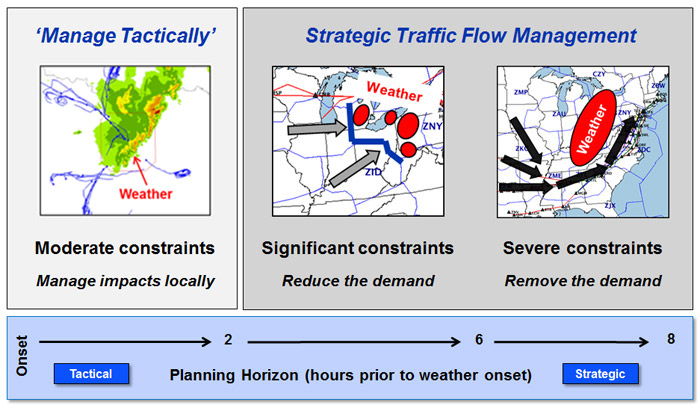Traffic Management Overview
Traffic Management versus Air Traffic Control
The primary responsibility of air traffic controllers is the separation of aircraft. They control traffic in and around airports and in the terminal and en route airspace in between. Controllers speak directly with pilots, notifying them of traffic or weather in their vicinity. Pilots depend on the instructions they receive from air traffic control to safely and efficiently travel from their origin to their destination.
In contrast, traffic managers facilitate a "system approach" to managing traffic that considers the impact of individual actions on the whole. Managing disruptions in airspace capacity (caused for example by bad weather, traffic overloads, or emergencies) requires consideration of who or what may be impacted by events, and a coordinated mitigation effort to ensure safety and efficiency in the delivery of air traffic services. Without a coordinated response, local flight delays due to small disruptions can quickly ripple across the entire United States, causing large-scale rerouting, flight cancellations, and significant widespread delays. Traffic management in the National Airspace System (NAS) is overseen by the Air Traffic Control System Command Center. Traffic management also takes place in enroute centers, in some of the large terminals, and in collaboration with other stakeholders in the NAS, including the airlines, general aviation, and the military.
Tactical versus Strategic Management in Convective Weather
Tactical traffic management typically refers to tasks or procedures carried out in less than 2 hours in a localized area. Strategic management refers to planning 2 to 8 hours out at a larger, perhaps regional or national scale.
The scale of convective weather impacts, typically thunderstorms, largely determines the severity and scope of traffic management initiatives that will be implemented and their lead time.

As shown in the left side of the diagram above, moderate constraints that impact local areas of terminal or enroute airspace can be managed tactically, up to 2 hours prior to onset of convective weather. As a line of storms (labeled Weather) hits the Dallas/Fort Worth Terminal Radar Approach Control facility (thin red octagon in center), the approaching aircraft, shown as blue dots with trailing blue lines, are placed in holding stacks (oval areas made up of several blue lines) until the weather clears the airport.
Significant regional weather constraints (middle image) must be managed strategically, 2-6 hours prior to the onset of convective weather. Pre-set boundaries called Flow Constrained Areas (FCAs) are shown as thick blue lines, and are used to control the demand through the weather impacted area. An Airspace Flow Program can be set to limit the traffic flow to a set number of aircraft per hour (shown as large gray arrows) across the FCA during the weather event (four large red ovals from Michigan to Pennsylvania, labeled Weather).
Large scale, intense convective weather (right image) can render airspace completely unusable. When this type of weather (large red oval stretching from New York to Tennessee labeled Weather) occurs, the full flow of aircraft scheduled for that airspace must be rerouted around the blockage. Large scale strategic traffic flow management requires lead times of 4-8 hours to modify the routing for large numbers of aircraft.
Today, the selection of strategic traffic management initiatives during convective weather events relies on experienced traffic flow managers interpreting evolving weather impacts, collaborating with NAS stakeholders, and planning traffic demand to fit within the available airspace. The challenges these managers face — hedging uncertainty in the weather impacts, preventing overload of en route and terminal resources, and equitably allocating the limited resources among airlines — are especially frequent during the summer, when the most thunderstorms and air traffic delays occur.
In general, strategic traffic flow management requires clear, high confidence predictions of weather impacts on airspace capacity 2-8 hours ahead of time. NextGen Weather provides a number of capabilities that support these operational needs, including 2-8 hour Predictive Products, Translation Products, and Confidence Metrics.
Additional Information
- How Air Traffic Control Works is a comprehensive, easy-to-understand article about ATC.
- Traffic Flow Management is explained by the National Business Aviation Association.
- Traffic Flow Management in the National Airspace System (PDF) is an FAA presentation.
